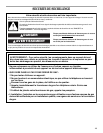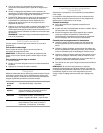
11
Removing Accumulated Lint
From Inside the Dryer Cabinet
Lint should be removed every 2 years, or more often, depending
on dryer usage. Cleaning should be done by a service technician.
From Inside the Exhaust Vent
Lint should be removed every 2 years, or more often, depending
on dryer usage.
If you have any questions or comments, please call a designated
Whirlpool service company.
Regular Servicing
To keep your dryer operating safely at best efficiency, regular
servicing by a designated Whirlpool service technician is
recommended. For normal use, this should be at 12 monthly
intervals. For heavy duty usage, this interval should be reduced
accordingly.
Vacation and Moving Care
Vacation care
Operate your dryer only when you are at home. If you will be on
vacation or not using your dryer for an extended period of time,
you should:
1. Disconnect power.
2. If you have a gas dryer, close shutoff valve in gas supply line.
3. Clean lint screen. See “Cleaning the Lint Screen.”
Moving care - Electric Dryers
1. Disconnect power. Disconnect wiring if dryer is direct wired.
2. Make sure leveling legs are secure in dryer base.
3. Use masking tape to secure dryer door.
Moving care - Gas Dryers
1. Unplug the power supply cord.
2. Close shutoff valve in gas supply line.
3. Disconnect gas supply line pipe and remove fittings attached
to dryer pipe.
4. Cap the open fuel supply line.
5. Make sure leveling legs are secure in dryer base.
6. Use masking tape to secure dryer door.
TROUBLESHOOTING
First try the solutions suggested here and possibly avoid the cost of a service call...
Clothes are not drying satisfactorily
■ Check the following:
Is the lint screen clogged with lint?
Is the exhaust vent or outside exhaust hood clogged with lint,
restricting air movement? Run the dryer for 5-10 minutes.
Hold your hand under the outside exhaust hood to check air
movement. If you do not feel air movement, clear exhaust
system of lint, or replace exhaust vent with a heavy metal or a
flexible metal vent. See “Installation Instructions.”
Is the exhaust vent crushed or kinked? Replace with heavy
metal or flexible metal vent. See “Installation Instructions.”
Has the electricity supply fuse blown, or has a circuit breaker
tripped?
Has an air dry cycle been selected? Select the right cycle for
the types of garments being dried. See “Drying, Cycle, and
Temperature Tips.”
For gas dryers, is the valve open on the supply line?
Are fabric softener sheets blocking the grille? Use only one
fabric softener sheet, and use it only once.
■ Is the dryer located in a room with temperature below
7ºC?
Proper operation of dryer cycles requires temperatures above
7ºC.
■ Was the load very wet?
Expect longer drying times with items that hold moisture
(cottons).
■ Is the load too large and heavy to dry quickly?
Separate the load to tumble freely.
Dryer will not run
■ Check the following:
Is the electricity supply connected?
Has the electricity supply fuse blown, or has a circuit breaker
tripped?
Was the correct supply fuse used?
Is the dryer door firmly closed?
Was the Start button firmly pressed?
Is a cycle selected?
Unusual sounds
■ Has the dryer had a period of non-use?
If the dryer hasn’t been used for a while, there may be a
thumping sound during the first few minutes of operation.
■ Is it a gas dryer?
The gas valve clicking is a normal operating sound.


















